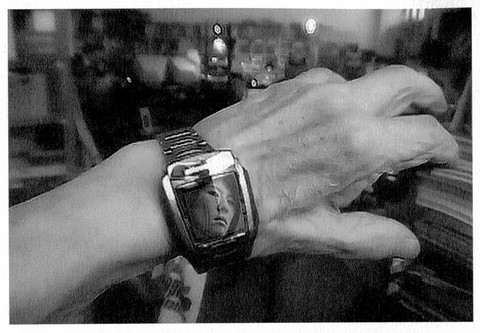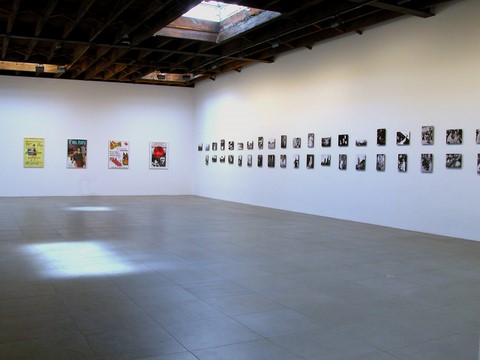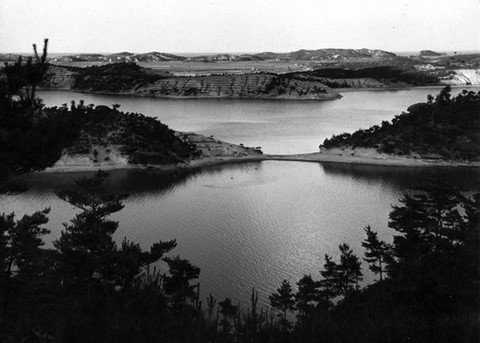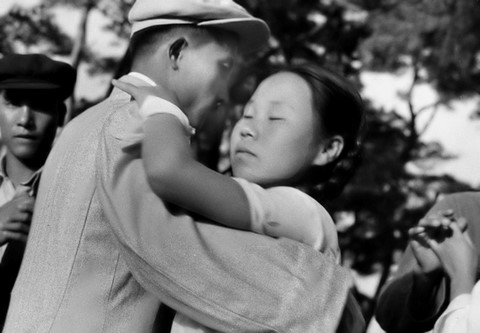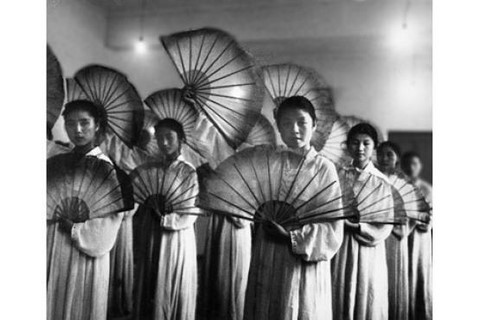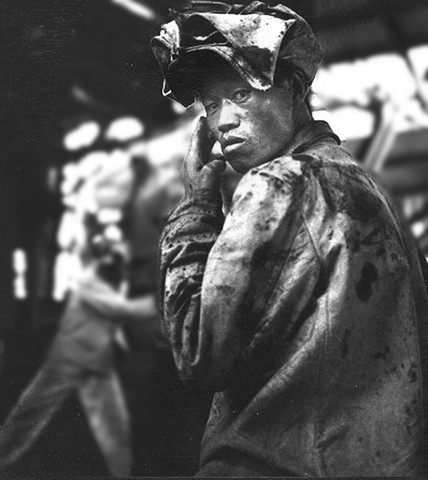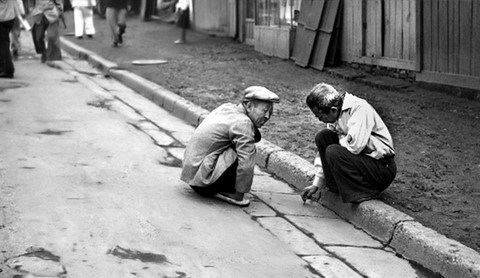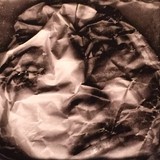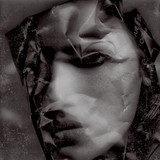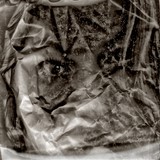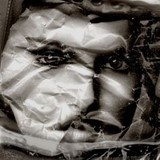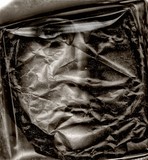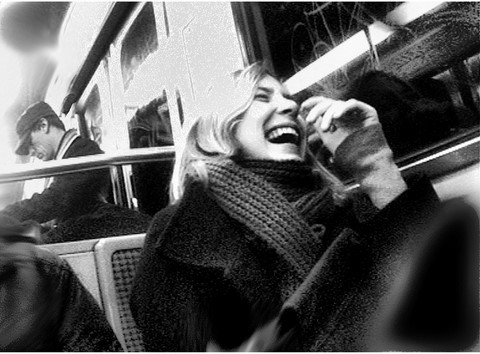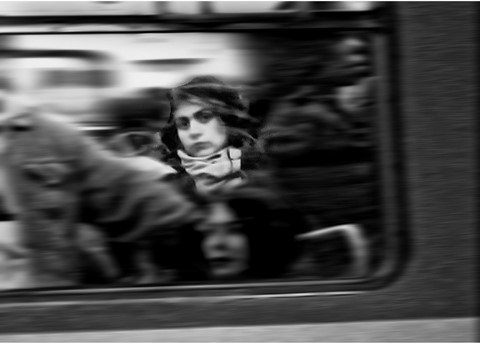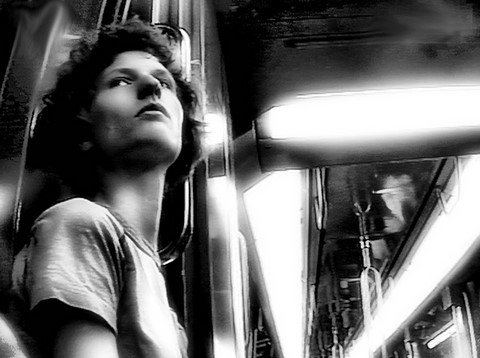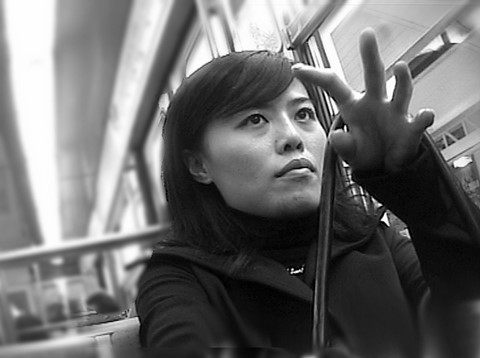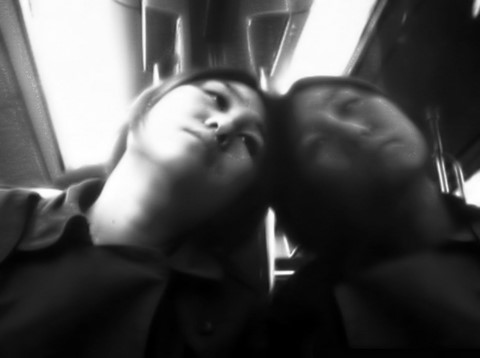Quelle heure est-elle ? (2009)
Deuxième collaboration avec la Peter Blum Gallery, "Quelle heure est-elle ?" s'est tenue du 16 mai au 31 juillet (prolongée jusqu'au 19 septembre) 2009, à la galerie Peter Blum Chelsea.
Elle est composée de trois séries différentes de photographies :
- Koreans (1957, retouchées en 2007-2008)
- Crush-Art (2003-2008)
- Quelle heure est-elle ? (2004-2008)
Auxquelles s'ajoutent des posters de films, des cartes postales et deux installations vidéos, à savoir Silent Movie (1995) et Owls at Noon (Prélude). The Hollow Men (2005).
Le tout a été exposé aux Rencontres d'Arles, en 2011, avec en complément la projection de La Jetée (1962) en boucle et un poste d'accès à Second Life, et plus particulièrement l'Ouvroir.
Koreans
Koreans regroupent 51 images prises durant le voyage de Marker en Corée du Nord en 1957, qui offre alors un regard non censuré sur l'état de la situation et la vie dans ce pays dévasté, quatre ans après la guerre.
Pour l'essentiel, ce sont une partie des 120 photographies noir et blanc édité dans l'ouvrage Coréennes de Marker, publié en 1959, au Seuil, mais retouchées par Marker en 2007-2008 à l'occasion de la réédition en coréen du dit livre, à Séoul.
Ce principe de retouche est celui que Marker appliquera dès la fin des années 1970 à toutes ses œuvres photographiques à venir et qui n'est pas sans rappeler le dialogue de Sans soleil (1982) :
"Mon ami Hayao Yamaneko a trouvé une solution : si les images du présent ne changent pas, changer les images du passé... Il m'a montré les bagarres des Sixties traitées par son synthétiseur. Des images moins menteuses, dit-il avec la conviction des fanatiques, que celles que tu vois à la télévision. Au moins elles se donnent pour ce qu'elles sont, des images, pas la forme transportable et compacte d'une réalité déjà inaccessible. Hayao appelle le monde de sa machine : la Zone - en hommage à Tarkovski."
"Chris Marker à l’Atelier Hermès
L’Atelier Hermès présente à Séoul un travail resté inédit en Corée depuis 1959 : la série photographique Coréennes de Chris Marker. Quelques mois après la disparition du réalisateur et photographe français, son œuvre dialogue avec des artistes de la scène coréenne qui lui rendent hommage.
C’est un projet historique que présente, en ce printemps 2013, l’Atelier Hermès autour du réalisateur et photographe français Chris Marker (1921-2012). Cette exposition, organisée avec son concours jusqu’à sa disparition, est consacrée à Coréennes, une série photographique datée de 1957, ainsi qu’à une sélection de films. Quatre ans après le terme de la guerre de Corée, Chris Marker fut l’un des rares journalistes autorisés à explorer la Corée du Nord. Il en a rapporté, outre des portraits de femmes, une chronique inédite du quotidien, qu’il décrit comme un court-métrage composé d’images fixes. Le recueil de photographies, censuré de part et d’autre de la frontière, est publié en 1959 aux Éditions du Seuil (France) qui le présentent comme un "ciné-essai", unique opus de l’éphémère collection Courts Métrages.
Œuvre référentielle pour l’art contemporain comme pour le cinéma expérimental, le travail de Chris Marker n’a jamais été exposé en Corée. Au sein de l’Atelier Hermès, à l’invitation de la commissaire Jee-Sook Beck, quatre artistes coréens se livrent à une "conversation imaginaire" avec l’auteur de La Jetée.
- Hong-Goo Kang utilise un format 6x6 identique à celui des Coréennes.
- Jae Oon Rho réinterprète en vidéo le paysage nord-coréen saisi par Chris Marker.
- Yoon-Suk Joon revisite sa narration et son engagement poétique dans une œuvre filmée qui met en exergue la scène politique nationale.
- Sejun Hwang, enfin, s’empare du voyage académique des intellectuels occidentaux représentés par Chris Marker à travers un travail pictural de facture traditionnelle.
Adresse : L'Atelier, Séoul, Corée 630-26 Shinsa-Dong, Gangnam-Gu, Séoul
Entrée libre : du 05/04/2013 au 11/06/2013
Commissaire d'exposition : Jee-Sook Beck
"In 1957, I had the opportunity to join a group of French journalists "invited" to visit North Korea. I would only realize later what a unique opportunity that was. The four years following the war (a conflict soberly described by General Bradley as the "wrong war, in the wrong place, at the wrong time, and with the wrong enemy") had been dedicated mostly to rebuild a bomb-stricken country, and the formidable propaganda machine that would soon be identified with the sheer mention of North Korea wasn't yet running at full throttle. We were subjected to a sizable dose of propaganda, but between two obligatory sessions of Socialist kowtowing, our hosts allowed us an amount of free walking unequalled since. Many years later, I could contemplate on television the predicament of a Belgian delegation whose members supplicated their guide to see, at least once, a marketplace - and after having visited the museum in honor of comrade Kim Jong-il, the library with the complete works of comrade Kim Jong-il, the factory that followed the directives of comrade Kim Jong-il, they were finally taken an empty space outside the city, where a marketplace would be established according to the plans of comrade Kim Jong-il. Watching the image of hopelessness on the faces of the poor wretches made me appriciate even more the liberty I had enjoyed to hang around Pyongyang with my camera and to look everywhere, including marketplaces. Amusingly, the result of those strolls was equally rejected on both sides of the 38th parallel. To the North, a book wich never mentioned once the name of Kim il-Sung simply didn't exist. To the South, the raw fact that it had been allowed to be done in North Korea made it a tool of communist propaganda. That's how, I was told, it was introduced as a "Marxist dog". I didn't mind. Since Snoopy, the world "dog" has ceased to be an insult in my cat-ruled world. Then Time froze on that country whose culture had fascinated me, as well as the mesmerizing beauty of its women, while the megalomaniac leadership of both Kims had proven a disaster. Many examples of that freeze would appear in the news, the most recent so incredible that it escaped many commentators. When the DPRK (that's its official name) launched the famous rocket that following communiqué : "The Secretariat of the C.C., the Communist Party of the Soviet Union fully supports the steadfast stand of the Worker's Party of Korea led by General Secretary Kim Jong Il". Yes, you read correctly : "Soviet Union". In 2009. Perhaps nobody ever dared to update comrade Kim Jong-il."
Crush Art
Crush-Art consiste en une série de 16 photographies de magazine représentant des portraits de femmes qui ont été chiffonnés avant d'être scannés. Le résultat final obtenu est une série de portraits de fantômes froissés qui défie notre compréhension du temps et de la beauté et qui, d'une certaine manière prenne le contrepoint des images ultra-photoshopées des revues de mode contemporaine.
"What's in a face ? I guess that for many, the head of a classical Greek statue, in its marmorean nakedness, could be accepted as the ultimate representation of beauty. Now if we could watch the eyes and mouth of these statues as the Greeks used to see them, colorized, maxfactorized, so outrageously painted that the description of Delphi by Pausanias veers toward Vegas more than to the Elgin Marbles, we probably would be puzzled. As probably would be an ancient Greek contemplating our antique galleries - unless he feels there the kind of melancholic appeasement that we sometimes experience in a junkyard. An even greater amazement would seize him at the Bardo museum in Tunis if he discovered the visitors marvelin before an Aphrodite rescued from a shipwreck, corroded by the sea in a manner that makes it closer to Brancusi than to Praxiteles. For modern art had the guts to challenge Time and Nature on their terrain, and methodically distort the human face, especially female. Out of despair ? Out of impatience ? Out of a pathetic desire to discover a beauty beyond the beauty ? The Nazis made no bones about these attempts, by coining the concept of Entartete Kunst, "degenrate art". I'm afraid my crushed faces would have fallen in that category, wich would have been a great honor, given my companions: Grosz, Chagall, Kokoschka... But of course it would be preposterous to compare my ambitions to theirs, and for a good reason (genius apart) : I have no ambition. The whole experiment happened in a totally automatic way (my generation having been shaped by vintage Surrealism) ; it's automatically that I began to crumble pages in magazines, then scan the result and meet a series of ghosts. I feel rather comfortable with ghosts, perhaps because they entered my life very early, perhaps because their strangeness looks more familiar to me than the impeccable standard they projected before crushing, perhaps for no reason at all."
Quelle heure est-elle ?
Enfin, Quelle heure est-elle ? est un projet, alors en cours, de 36 portraits de femmes saisies, entre 2004 et 2008, dans le métro, à leur insu grâce à la caméra cachée d'une montre bracelet. On en retrouve les germes dans Le Dépays (1982), dans lequel Marker décrit le plaisir qu'il a à photographier les gens dans le métro japonais, en particulier les dormeurs. Le cédérom Immemory (1997) propose d'ailleurs une version numérique du Dépays qui comprend un plus grand nombre de photographie de japonais(es) dormant dans le métro, dont peut-être cette mystérieuse femme qu'il a photographié ainsi à l'envie, dormant, mais dont il se refusait de diffuser les images par respect, disait-il à l'époque.
Par ailleurs, en 2008, Marler réalisera un "diaporama" de photographies en noir et blanc de femmes prises dans le métro parisien suivant des procédés similaire. Intitulé Metrotopia, ce court métrage de 4'12 est visionnable sur Youtube, sous le pseudonyme de Kosinki.
Poursuivant sa lancée, le projet de photographies "volées" dans le métro parisien aboutira à travers l'exposition Passengers, une série de plus de 200 photographies couleurs montrée pour la première fois à la Peter Blum Gallery en 2011, et qui sera la dernière exposition de photographie de Chris Marker qui, dès lors, se tournera vers des courts métrages - diaporamas sur Youtube ou sur sa toute dernière œuvre, gorgomancy.net.
Catalogue d'exposition "Quelle heure est-elle ?" (2009)
"The apparition of these faces in the crowd / Petals on a wet, black bough"...
The short unforgettable poem by Ezra Pound was my first idea of an epigraph for another photo exhibition, STARING BACK. Then I decided to drop the epigraph. Too easy to shelter yourself behind a great poet, like a metaphorical bulletproof jacket, methought. Please note that I didn't mention that repressed idea to anyone. Then came the first reviews. And Brian Dillon's piece in Art Review started with : "The apparition of these faces in the crowd / Petals on a wet, black bough" - after wich he elaborated on the kinship between those verses and the mood of my photographs. I was thunderstruck. So it was true, after all, there existed such a thing as poetry, whose ways are by nature different from the ways of the world, that makes one see what was kept hidden, and hear what was kept silent. I had always been conviced that in my small essays, the untold part was more meaningful than the blabbering, and there I had the burning proof. This time I won't shy away from quoting Pound, and I guess that with this latest experiment inside the Paris subway it fits even better. Petals are for sure theses visages I capture with a hidden camera, like the benevolent paparazzo. Stolen, yes, but by another trick of the mirror, here stealing means giving. Tabloids love to catch people (preferably celebrities) unaware, if possible with an awkward or ridiculous expression, things that happen mechanically, independent of the subject's real intention. When I was a kid, French president Poincaré once visited a WWI graveyard under a blazing sun, and the extreme light made appear on his face, for one-tenth of a second, a rictus that could be mistaken for a grin. A photograph caught that moment, and for the rest of his career he was berated by this Rightist opponents as "the man who laughs in cemeteries". It may be that this childhood memory helped me to generate a defiant curiosité toward images. So my aim in collecting these "petals" is exactly - small wonder - the opposite of tabloids. I try to give them their best moment, often imperceptible in the stream of time, sometimes 1/50 of a second that makes them truer to their inner selves. And for that the hidden camera is a necessity. Even today, in the maelstrom of audiovisual machines, when people make movies with their cellphones, most remain camera conscious, and if rarely hostile, when they spot the lens they cease to be natural. Girls generally smile, wich is delightful but may turn monotonous, others search for their best profile, others simply cringe... Here I caught them innocent like animals, in the beauty of the jungle. Then I used different contraptions but I kept the title, for my personal pleasure and also because the stolen moment of a woman's face tells something about Time itself... But that's another story and, oh yes, I had almost forgotten the title of Pound's poem : it was written in Paris, and the title is "In a Station of the Metro" (nous soulignons).
Bibliographie :
- (GB) Rainer J. HANSHE, "The crisis of cognition. On memory and perception in Chris Marker's The Hollow Men. Chris Marker, Quelle heure est-elle ? ", Hyperion : on the future of aesthetics, vol. VI, n° 1 (04/2009), p. 25-36 (web)
- (GB) Anne DORAN "Chris Marker, Quelle heure est-elle ? ", timeout.com, 07/07/2009, en ligne (web)
- (GB) Anne DORAN "Chris Marker, Quelle heure est-elle ? ", Time out New York, n° n/a (09/07/2009), p. 38
- (GB) Jonas CUENIN, "Chris Marker, Quelle heure est-elle ? ", loeildelaphotographie.com, 04/07/2011, en ligne (web)
- anonyme, "Chris Marker aime les femmes (Arles 6)", lunettesrouges.blog.lemonde.fr, 06/07/2011, en ligne (web)
- Jean-Jacques BIRGE, "Chris Marker, moires et mémoires", blogs.mediapart.fr, 08/07/2011, en ligne (web)

